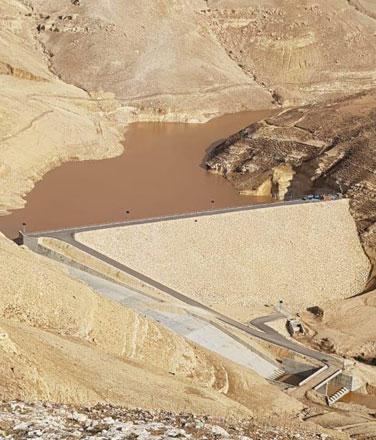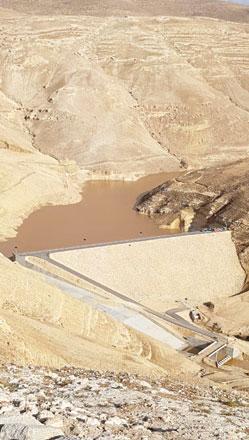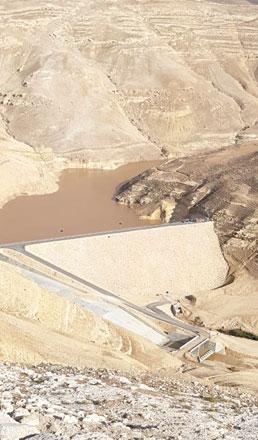You are here
Zarqa-Maeen Dam ‘irrelevant’ in Dead Sea tragedy
By Hana Namrouqa - Nov 08,2018 - Last updated at Nov 08,2018

General view of the Zarqa-Maeen Dam in Madaba Governorate, 30km southwest of Amman, is pictured in this recent photo (Photo courtesy of the Water Ministry)
AMMAN — Official reports and site inspections proved that the Zarqa-Maeen Dam, rumoured to have caused or worsened late October’s Dead Sea tragedy, was completely empty of any water prior to the day of the incident, the dam’s supervisor said on Thursday.
The dam was entirely empty between August 30 and October 25, when 15 minutes of quick rain channelled around 500,000 cubic metres of water into the 2-million-cubic-metre dam, Edris Hababseh said.
On the day of the incident, which Jordanians now refer to as the “black Thursday”, the Dead Sea area witnessed flashfloods after the country received heavy, quick rain. Rainwater from the mountains of the capital, Maeen and Madaba, among other areas, found its way through valleys before reaching the Dead Sea area.
A group of students, their teachers and tour guides, as well as family members, were swept away in a killer flashflood that suddenly submerged the Zarqa-Maeen Valley, where the schoolchildren were hiking. Twenty-one people, 16 of whom were children from the same school, were swept to their death, while 43 others were injured.
Following the incident, news reports circulated on social media claiming that the Wadi Zarqa-Maeen Dam, a newly established reservoir some 20 kilometres upstream from the Zarqa-Maeen Valley, had caused the tragedy when its gates were allegedly opened to let out excessive water or because the dam’s body was faulty and collapsed.
The Water Ministry and independent experts, who inspected the dam following the incident, denied the allegations, stating that “the dam has no floodgates in the first place” and that its outlet point only allows 50-70 cubic metres of water per minute to seep down the valley for farmers’ use.
The catchment area of the Zarqa-Maeen Valley, where the incident occurred, stretches over 272 kilometres, 182 kilometres of which are upstream from the dam and 90 kilometres are downstream, Hababseh said, indicating that rainwater from 40 side-valleys pour into the Zarqa-Maeen Valley.
“As for calculating storage of water at the dam, staff gauges at the dam show to experts and any interested layman from the local community the actual storage of water at the dam,” Hababseh noted.
Many rumours have been circulated about the Wadi Zarqa-Maeen Dam and its role in the Dead Sea tragedy. Therefore, it is important to further clarify and provide information on the nature of rainfall on this tragic day, the supervisor continued.
The Wadi Zarqa-Maeen Dam was completed last year, when storage there was tested and proved to be 100 per cent safe, according to the ministry, which indicated that the dam now stores 25 per cent of its total capacity.
The Jordan Valley Authority started construction work on the JD10 million Wadi Zarqa-Maeen Dam in 2015, with the aim of storing floodwater for drinking and irrigation purposes.
The dam aims to protect the environment and people from flashfloods, provide additional water for crop irrigation and tourist ventures and to expand agricultural lands in the surrounding area, which stretches from Wadi Zarqa-Maeen towards the Jordan Valley, according to the ministry.
Related Articles
AMMAN — A team of independent experts in construction, hydrology and geology received on Wednesday a government-complied report on the Zarqa
AMMAN — The Ministry of Water and Irrigation on Saturday denied as baseless news reports circulating on social media claiming the ministry o
AMMAN — Hisham Abu Haisah, director of dams at the Jordan Valley Authority, said that the Zarqa-Maeen Dam stored water for the first time la



















